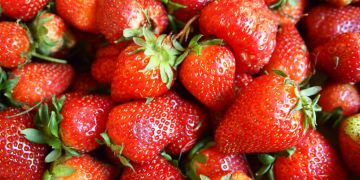Formed inside separate carpels of each flower, strawberries fall within the aggregate fruit category much like blackberries and raspberries. Strawberries belong to the Fragaria genus of plant from the family Rosaceae (Fragaria × ananassa). In actuality, strawberries are a hybrid species of fruit where the flesh or fruit portion grows out of the ovary receptacle instead of the ovary itself. Because of this growth pattern, strawberries are not considered true berries.
As one of the more adaptable fruit varieties, strawberries are grown throughout the world especially in the sunnier climates. This fruit is chocked full of vital nutrients yet only contains 55 calories per cup measure.
Active Ingredients
On average, eight strawberries can provide nearly 120 percent of the recommended daily intake for vitamin C. This high vitamin C content contributes to the antioxidanteffects strawberries have. Other ingredients, known as phytochemicals carry even higher levels of antioxidant compounds than the vitamin C content offers. Strawberries contain several categories of phytochemicals, some of which include:
- Ellagic acid
- Anthocyanins
- Pterostilbene
Antioxidants in general help protect cells from damaging free radical materials by strengthening cell structures. The anthocyanins in particular are what give red strawberries their ruby red color.
High Fiber Content
As an aggregate fruit, a strawberry consists of tiny single fruits contained inside a fleshy receptacle. The tiny white (or yellow) specks found on the outside of the berry – what most people consider as seeds – are the actual fruit portion while the tasty portion is the fleshy receptacle. These seed-like specks – also known as achenes – account for the high fiber content found in strawberries. Strawberries in general have around 200 seeds each regardless of their actual size. For food comparison purposes, this means a half cup of strawberries has more fiber content than a slice of whole wheat bread.
Anti-Inflammatory
Chronic inflammation is a known precursor to many types of disease conditions, such as type-2 diabetes, osteoporosis and Alzheimer’s. The British Journal of Nutrition describes a study on the effects of strawberries on the body’s inflammation and insulin responses in adults. The results from the study showed strawberries to lower the body’s level of inflammation biomarkers by 25 percent in 24 overweight adults. Researchers concluded that a diet containing daily portions of strawberries may help reduce the risk of developing inflammation-related conditions.
Heart Health Benefits
Their combined antioxidant properties and high fiber content make strawberries a strong ally in the fight against heart disease. As antioxidants help promote healthy cell function, cells are better able to move nutrient materials in and waste materials out. With high amounts of fiber, blood vessels remain smooth and free of fatty blockages which are known to slow blood flow and deprive the heart of needed blood supplies. These same effects from strawberries also lower the risk of high blood pressure since it takes less work for the heart to move blood throughout the body.
Anti-Aging Properties
Strawberry extracts contain high levels of enzyme materials which help cells fight against the body’s aging process. In general, aging results from oxidative stress caused by weakened cell functions. Oxidative stress occurs when cells become unable to eliminate waste materials created during cell metabolism processes. A study conducted by Tufts University and the University of Maryland tested the effects of strawberry extracts on rats exposed to radioactive energy, which affects cells in much the same way as waste materials. The results of the study showed the rats receiving strawberry extract suffered fewer aging effects in terms of cognitive functions and motor skills.
Preparation
For anyone considering strawberries as a supplement within their daily diet, this fruit can be prepared in many ways each of which may produce different effects. Various cultures use strawberries to treat a range of health conditions. Within Native American cultures and European folk medicine, the root of the strawberry is boiled to make a tea for treating indigestion, kidney stones and as a diuretic.
Teas can also be made from the root and leaves of the strawberry plant. In this form, strawberry can be used to treat diarrhea as well as urinary tract infections, night sweats and fatigue.
Strawberry extracts are also available in tincture form, which can be added to water in droplets. Extracts may also come in capsule form of up to 500 milligrams per capsule.





